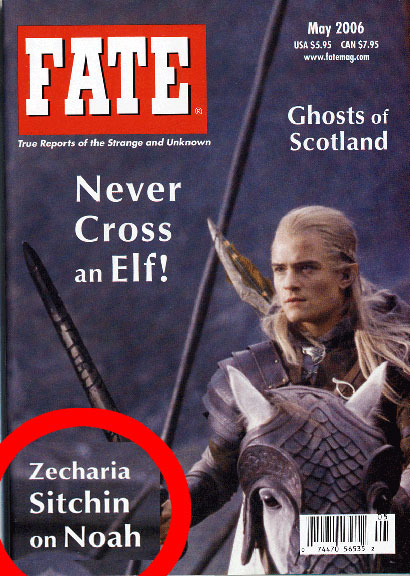So, You See, As Nibiru Orbits...
From Our Readers
The Case of The 'Yo-Yo Planet'
NICE NEWS FROM THE 'NICE GROUP'
Global Warming: WILL TECHNOLOGIES OF THE GODS COME TO THE RESCUE?
Science News: NEW DISCOVERIES CORROBORATE SITCHIN
"ENKI", "NIBIRU" DOMINATE "2012" SYMPOSIUM
EXCITING DISCOVERY IN THE SOUTHERN FISH
THE ENIGMA OF THE ‘PHAESTOS DISC’
IS THE PAST OUR FUTURE?
AS I WAS SAYING…
SO WHAT IS IT?
EXISTENCE OF SECRET CHAMBER IN GREAT PYRAMID REVEALED BY NEW STARTLING BOOK
ROBBING PLUTO OF ITS PLANETHOOD: Leave It The Way The Sumerians Had It Says Author Zecharia Sitchin
In The Media
In The Media: FATE Magazine, May 2006
When Calamity Strikes Mankind: THE "TSUNAMI" OF 10,900 B.C.
Q & A
In The Media: FATE Magazine, May 2006
A DOOMSDAY ‘NOAH’S ARK’
Phyllis Galde’s column, "I See By The Papers,” provides some of the most thought provoking reading in every issue of FATE magazine, and as often as not includes a news item that links the Present to the Future through the Past.
One such recent item, titled The Doomsday Vault (FATE, March 2006), reports plans to carve out on the Norwegian Island of Spitzbergen an artificial mountain cave in which about “two million seeds, representing all known varieties of the world’s food crops,” would be safely kept from destruction by natural or manmade disasters.
I found intriguing the added comment by the project’s initiators that this will safeguard for mankind “the products of some 10,000 years of plant breeding by the world’s farmers;” intriguing because it was indeed some ten thousand years ago, following an overwhelming catastrophe known as the Great Flood -- that not only crops but also animal life were restored thanks to a seed preservation project.

The biblical tale of the Great Flood is told as a bad cop/good cop story. In the first part, God was angry with Mankind and decided it should perish in the watery avalanche. Then God decided to save the human race and other life forms by telling Noah to build an ark that will survive the catastrophe, and take on board his family (for Mankind’s survival) and all manner of animals, in male & female pairs.
Critics Of the Bible have pointed out that the ark, whose dimensions are given, could not have possibly hold all the purported animal species. The valid comment has, however, a simple yet an amazing explanation.
We now know that the biblical deluge tale came from earlier sources - the writings of the Sumerian civilization that blossomed out in Mesopotamia (mostly today’s Iraq) some 6,000 years ago. In that tale it is one god, Enlil, who seeks Mankind’s demise, and another (Enki) who devises the rescue plan. The latter was the Mesopotamian god of science, a great biologist who was involved in genetically upgrading Homo erectus to Homo sapiens. And what did he provide to Noah to take aboard to save animal and crop life? The Sumerian text clearly answers: the “Seed of Life,” the DNA of animals and crops not the animals as such!
Modern science attributes the appearance - some 10,000 years ago -- of certain animals (such as sheep) and plants (cereal crops) to Man’s gradual “domestication” efforts. The Sumerians credit that to the gods:
After the Deluge, a relenting Enlil joined Enki at a mountaintop laboratory to reconstitute there the animals (starting with sheep) and crops (starting with wheat and barley) from the saved DNA. Several Sumerian texts, cited in my books The Twelfth Planet and Genesis Revisited describe the process in great detail.
The seed preservation plan in Spitzbergen is thus not the first effort to biologically preserve earth’s life from a catastrophic occurrence...
Several years ago British scientists announced the “Frozen Ark Project” to preserve, as a start, the DNA of endangered species, and then of another ten thousand living creatures -- a kind of "Jurassic Park” in laboratory flasks
A similar project called the Frozen Zoo was undertaken by the San Diego Zoo. Other zoos and biological centers, in Australia, China and India have also announced similar plans.
Some of them recognize the similarity of their efforts to the Bible’s tale of Noah’s Ark. Few, if any, realize that the similarity is much more profound - that modem science is just catching up with ancient knowledge.
© Z. Sltchin 2006

















